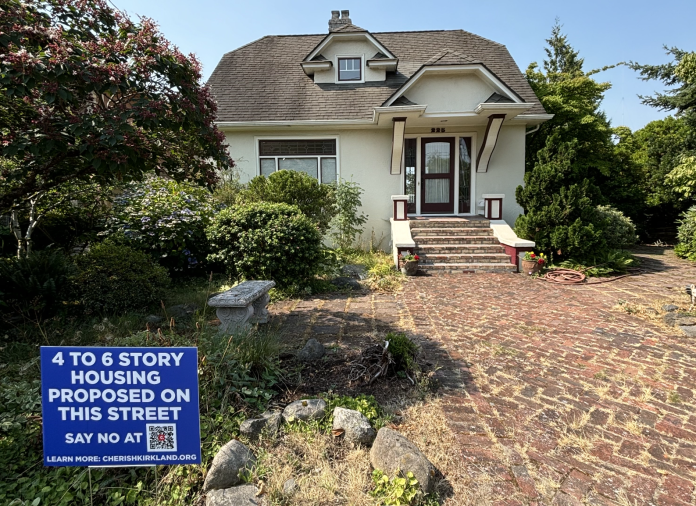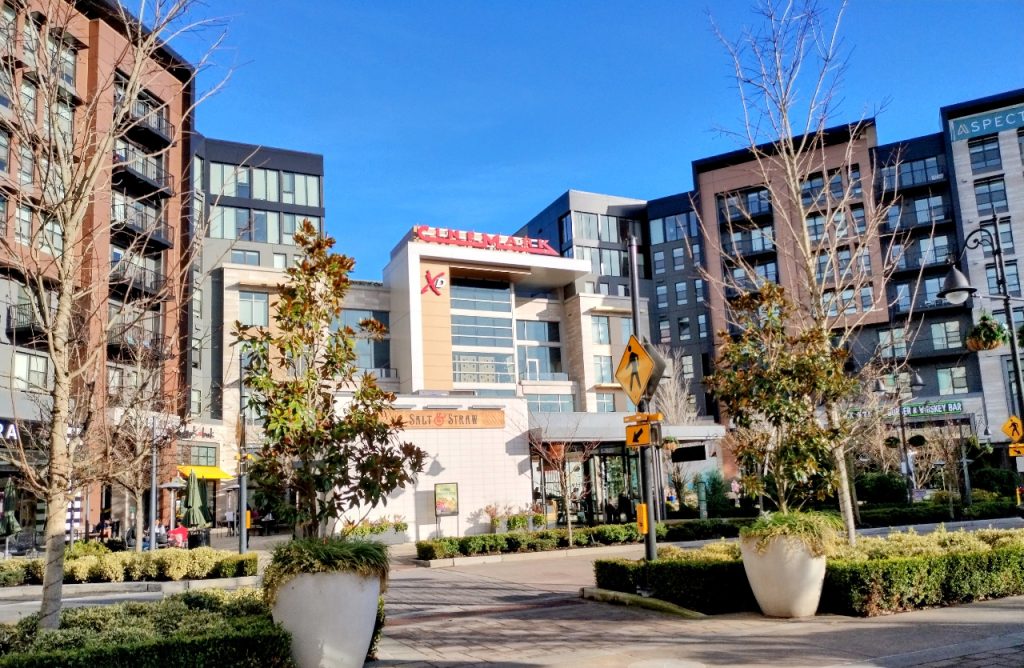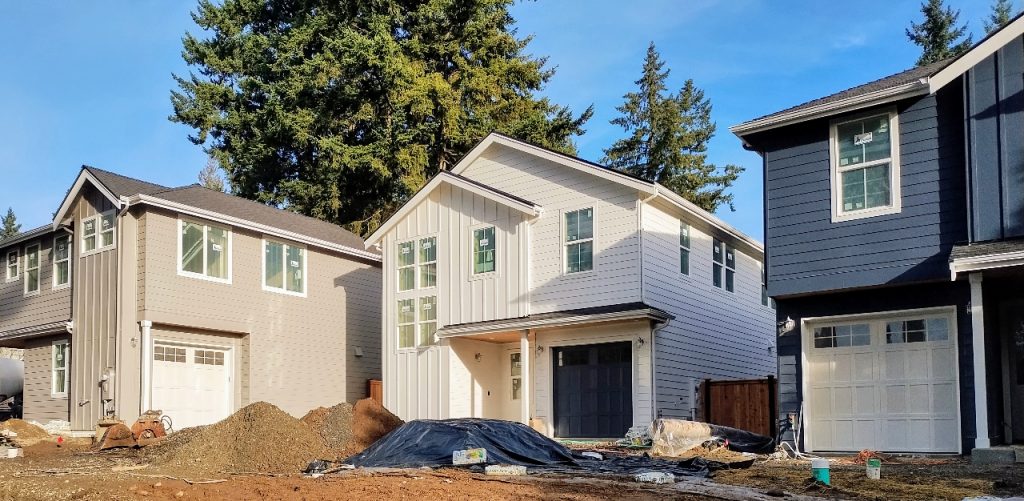
A sizable crowd packed last week’s Kirkland Planning Commission meeting to weigh in on whether the update to Kirkland’s Comprehensive Plan should recommend that the City study increasing allowed housing density near frequent transit corridors. While no zoning changes are yet being proposed, the commission heard more than three hours of testimony, with many speakers pushing to drop language around creating “higher-intensity residential uses” close to transit from the comp plan.
On the flip side, dozens of speakers asked the city to do more to create a Kirkland that is affordable and welcoming through increased housing opportunities and density.
Many at Thursday’s meeting were likely prompted to attend by yard signs that have been popping up around Kirkland’s lower density zones in recent weeks warning of “4 to 6 story housing proposed on this street.” The QR code on the sign links to the website of a new group, Cherish Kirkland, which has created a petition pushing back on “residential neighborhood densification” in Kirkland.
“We are against the changes to the Comprehensive Plan that permit 4-6 story buildings 1/4 mile deep into our neighborhoods along identified ‘transit corridors’,” the petition states. “As shown on the map, the changes radically increase density allowances for huge parts of Bridle Trails, South Rose Hill, North Rose Hill, the Highlands, Norkirk, Juanita, and virtually all of Totem Lake, Moss Bay, Everest, Lakeview, Central Houghton, and Market.”
Cherish Kirkland distorts the facts over what the comp plan language would accomplish; nothing in a city’s comp plan changes zoning by itself, nor does it compel City Council to act at a later date. As part of the environmental review for the Kirkland Comprehensive Plan, the City did study options increasing density along the bus routes that see buses every 15 minutes throughout the day on weekdays, or corridors where that service is expected in the future, including the area along the future RapidRide K Line route. Densities of 50 dwelling units per acre were studied, which generally translates to townhomes or small apartment buildings. But that was a study baseline, and not an actual proposal.

As Allison Zike, Kirkland’s Deputy Planning and Building Director, told the planning commission, the study the City completed only sets the stage for future decisions. “What is decided in the land use element is the framework for future projects that could amend the zoning code, so it’s really a first step that gives us some direction to how we will start exploring zoning code amendments, but it doesn’t mean the zoning code would be amended — so it’s our starting point,” Zike said.
Zike noted that Kirkland’s current Comprehensive Plan, adopted in 2015, includes language encouraging more density around frequent transit, though those connections are less direct, recommending that the city “provide a land use pattern and connected transportation network” that promotes multimodal safety and reduces overall driving in the city.
Over the past few years, Kirkland has been ahead of the rest of the region on housing action, legalizing “missing middle” housing in 2020, a full two years before the state legislature passed statewide reform via HB 1110, requiring local jurisdictions to permit multiplexes in single-family neighborhoods across the state by July 2025.
Last year, Kirkland voters reelected two councilmembers running for reelection who had been running on broad pro-housing platforms — Kelli Curtis and Amy Falcone — by substantial margins. It looked like voters were resoundingly behind the idea of continuing to densify, at least in the growth centers Kirkland had already identified, including Totem Lake and the area around the planned Sound Transit Stride bus rapid transit station at NE 85th Street.

Earlier this month, the Kirkland City Council held a discussion on adding the potential language, with most councilmembers supportive of potential tweaks in response to community concerns, but not removing it entirely as many anti-growth advocates have sought
“Given what we’ve learned about best practices in urban planning over the past 80 years, it behooves us to have this concept for future study and potential implementation in our smart growth plan, and that’s what our comp plan is: a plan for thoughtful, smart, intentional growth,” Councilmember Neil Black said.
Black said the city does have additional work to do to look at infrastructure needed to accommodate new growth.
“I would like to see it revised to clearly address the concerns we’ve heard, by stating that we must plan responsibly for the needed accompanying infrastructure and services,” Councilmember Amy Falcone said. “With the transit that’s planned for the future, we need to plan for housing intensity concurrently.”
“I support the idea of new density on the transit corridors that must be coupled with actual frequent transit service, pedestrian and bicycle safety, adequate school capacity, access to parks and open space,” Mayor Kelli Curtis said. “I’m interested in having staff and Planning Commission develop these concepts further, to provide more definition and certainty around timelines and circumstances that would shape any rezoning of transit corridors, and what those expectations are in those corridors.”
Kirkland’s Deputy Mayor Jay Arnold also wanted to keep the language, and then get into the details of what it looks like to increase density on transit corridors, based on the actual level of current or planned transit service. “Unlike some of the email I’ve gotten, I’m not in favor of five-story buildings everywhere you see on that map, and I don’t think any of us are,” Arnold said. “I want to see some nuance on this, I want to see where it might be appropriate for more multifamily buildings, and I think that’s going to be corridor-specific.”
“If we want the people who work here to be able to live here, we have to have housing available for them to do so,” Councilmember Penny Sweet said. “I support moving forward with the capacity analysis […] this doesn’t mean we’re going to put five-story buildings all along the transit corridors, it’s not realistic.”
The council was not unanimous in that sentiment, though. Councilmember John Tymczyszyn, newly elected this year and a long-term member of the Kirkland Planning Commission, did want to remove the language entirely and continue focusing on the city’s existing growth centers.
“I want to see us double down on 85th, on our commercial centers and our middle housing, and the time, effort and energy that has been spent on this, I’d like to stop,” Tymczyszyn said. “I do not support any further advancement of this idea, or any further studying of it, further ideological debate on it, and I would like to refocus our city’s efforts on things that I think will be truly successful and produce housing within this decade.”
Kirkland has seen an uptick in permits for middle housing since the 2020 reforms were approved, but overall those gains have been fairly modest. The majority of permit applications for middle housing are coming in as accessory dwelling units (ADUs), with just 17 permits for duplexes and three-unit buildings citywide since 2020, according to the City’s affordable housing dashboard.

Tymczyszyn was joined in skepticism by Councilmember Jon Pascal, who called the language not ready for prime time and raised concerns about the level of environmental analysis that had been done.
“I feel strongly that we need to stay focused on our existing policies, our goals, our commitment to building infrastructure [and] services, to make the plans that we have been focusing on over the last decade a reality,” Pascal said. “And I’m concerned this policy takes our eye off the ball and results in unintended outcomes that don’t get us closer to the goals that we all strive to achieve.”
By last week’s planning commission meeting, the proposed comp plan language had been revised to instead direct the city to “explore” additional density once the area around the NE 85th Street Stride station has met its target for affordable units. The revision also set a prioritization framework that puts the K Line at the forefront of the discussion around potential upzones near transit and other lines further down the list.
The majority of the planning commission also seemed supportive of keeping the language, though they will not make a final decision until next month.
“I do support keeping [the language] in some form, I definitely think there should be improvements,” Commissioner Aaron Jacobson said. “I think we need to have a conversation about what corridors make sense. I don’t like the idea of removing corridors right now for political reasons, that is just the root of exclusionary zoning. I’m looking for, what are the factors and criteria that may affect one corridor more than others, but are reasonable factors to be concerned about on any corridor, so that we have a fair process.”
With so much scrutiny on a few brief sentences in the Comprehensive Plan, everyone will be watching to see how the Kirkland City Council chooses to move this idea forward this fall as they adopt the final plan ahead of the state deadline of December 31. It appears most members are seeking a consensus that doesn’t take the city backward on addressing the region’s housing crisis.
Ryan Packer has been writing for The Urbanist since 2015, and currently reports full-time as Contributing Editor. Their beats are transportation, land use, public space, traffic safety, and obscure community meetings. Packer has also reported for other regional outlets including BikePortland, Seattle Met, and PubliCola. They live in the Capitol Hill neighborhood of Seattle.

